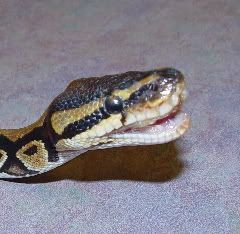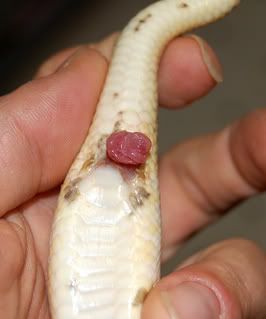| T O P I C R E V I E W |
| wolfspirit |
Posted - 07/05/2009 : 13:40:56
As i had time on my hands today i put this together, if anyone can add to it then feel free..
It is my wish that it will help to stop snakes from suffering...and i hope this goes at least a tiny bit towards that.
Trying to take shortcuts and treat a snake yourself to save money could result in the illness/injury becoming worse or even the death of your snake.
The information given on this page is only a guideline, you should ALWAYS seek veterinary treatment from a qualified rep vet before attempting to treat your snake for any ailment
Common Health Problems In Snakes
Decided to write this as there are a host of things that can go wrong with snakes if not cared for properly..
Snakes for the most part are pretty easy to keep as long as you stick to the rules of keeping them in a suitable environment for age and size, maintain correct temps, and keep them clean, including spot cleaning and completely disinfecting there environment and bedding regularly. Don't over handle your snake.
A snake should have nice clear eyes, clean nose and mouth, be active, eat regular and have healthy skin.
Common signs of illness with snakes, is normally first seen when they may stop eating or become lethargic, you may also find runny noses, bad sheds and more. These are all signs that something may not be quite right.
Here is a list of the more common ailments
Abscesses
these are caused by untreated bites or an injury that has become infected, they can also occur at the site of an injection, an abscess can normally be recognised by a lump that is external and/or internal.
An abscess will need veterinary treatment and will need to be lanced to drain fluids and may also need a course of antibiotics to clear up the infection.
Blister Disease. Also known as “vesicular dermatitis, necrotizing dermatitis or “scale rot”

Blister disease is caused by poor living conditions, the snake being kept on a damp substrate, often saturated with urine, faeces or rotting food hence the skin becomes infected and effectively “rots”
The first signs are normally blisters, the blisters burst and the infection enters the snakes body leading to septicaemia ( blood poisoning) .
This disease if left untreated is fatal, and if you find anything resembling blisters on the belly, immediate veterinary treatment is needed.
Removal of rotting skin and tissue is necessary and antibiotics will need to be administered.
If the infection is in its early stages, then it is likely you will be given Betadine to soak the snakes body in.
The snakes enclose will have to be thoroughly disinfected with F10 on a weekly basis, uneaten foods and faeces to be removed.
Replace the substrate with unprinted paper (newsprint, paper towels, butcher paper), clean terry cloth towels, or plain lino and remove any heat mats and use infra red or ceramic heat to provide warmth.
In general, keep the reptile in a dry environment with good ventilation. If the reptile is still eating and active, then there is a good chance of full recovery.
Not all blisters are caused by blister disease, some are caused by burns to the skin from chemical residues used to clean out vivs ..Use F10 instead it is non toxic.
The answer to prevent this happening in the first place is to make sure you keep your snake meticulously clean.
Burns

Snakes most commonly get burnt when laying on heat mats, or by unprotected heat bulbs and other unprotected heat sources. heat mats are not recommended for use with heavy bodied snakes
treatment for these burns is needed quickly to stop them becoming infected.
You may be able to treat them at home if the burn is not severe with Betadine solution.
These injuries are easily avoided by taking time to make sure all heat sources and thermostats are working correctly, and are guarded where necessary.
Constipation
Is a common problem among captive snakes.
Causes include incorrect temperatures, illness, dehydration, injuries, parasites.
Signs of this occurring in your snake may be
Bloated/Lethargic or maybe even a decreased appetite.
Constipated snakes should be allowed to soak in very warm (not scalding hot) water for 20-30 minutes daily for 1-2 days.
This often results in defecation and/or urination.
If this fails to help the snake with bowel movements and there is any swelling in the abdominal area then veterinary help should be sought at once.
Build up of faeces can also indicate a blockage somewhere inside, i.e. a foreign object.
Remember Royals tend to defecate every 4-6 weeks sometimes sooner.
Cuts
Sometimes snakes will cut themselves on sharp edges in there vivs.
Any cuts should be kept clean and treated daily with tamodine or a similar wound skin cleaner until healed.
See if you can find out what the snake injured itself on and remove that object, snakes can also get abrasions from rubbing there noses on the vivs.
Internal Parasites
Snakes can be host to a whole number of parasites, but these are normally restricted to wild snakes and not common in captive ones.
Internal parasites are normally passed by the prey they eat or contact with another reptile that has parasites. Making quarantine important when bringing in a new reptile.
Common signs of internal parasites can include regurgitation, lack of appetite, and an overall ill appearance.
If you think that your snake has parasites, take a faecal sample to your vet so treatment can be started.
It is not common for pet snakes to carry internal parasites.
Mouth Rot

Mouth Rot is a progressive bacterial infection of the mouth.
Caused by bacteria in the mouth that gets into an open wound causing an infection in the lining of the gums.
An increase of saliva or bubbles from the mouth are an indication that something is wrong.
The lining of the mouth will become inflamed and pus ( cheesy yellow or yellowy-gray plaques in the soft gum tissue in the mouth ) will form there may be swelling or change in the colour of your snake's mouth and gums, the snake may not be able to close its mouth properly and can often seen frequently rubbing or opening its mouth. Its head may also be swollen and teeth falling out.
It is imperative that this disease is recognised at its earliest stage as If untreated, Mouth Rot will destroy the mouth lining and kill the snake. . You will need veterinary treatment for this froma qualified reptile vet.
Prolapse

When the hemipenis of a male snake prolapses and does not retract back inside, this is called paraphimosis.
Male snakes have two hemipenes used for copulation. They are normally situated in blind sacs behind the cloaca, what you called his hole. On occasion, one or both of these organs may pop out of the sac during defecation or during periods of sexual activity.
You can try soaking the snake in a cool bath to which sugar has been added. Heavy concentrations of sugar in the water will act to draw out the fluids engorging the swollen everted tissue; this may reduce it enough to allow it to go back in, but the snake will still need veterinary treatment. If the soaking does not work within an hour, and you should not attempt manual replacement, the snake should be placed on a damp towel and taken to the vet as quickly as possible.
If you suspect a prolapse, then immediate veterinary treatment should be obtained.
Regurgitation
Regurgitation is normally caused by stress or handling too soon after a meal
You should always wait at least two days after feeding your snake before you try to handle it.
Making sure your snake has a warm spot or hide to lay in after eating will aid in digestion of its meal. Low temperatures can also cause regurgitation.
Food that is too big may also be regurgitated, making sure that you feed prey no larger than the snakes girth will help avoid this.
If your snake does regurgitate his meal, then you should avoid any handling and do not feed again for at least another ten days. The next meal should be small, if the snake keeps this down then wait a further seven days before offering its normal sized meal again.
If you think that your snake may have some other illness, take him to a vet.
REMEMBER you should ALWAYS seek veterinary treatment from a qualified rep vet if you think your snake is ill.
|
| 12 L A T E S T R E P L I E S (Newest First) |
| sultanheart |
Posted - 12/11/2011 : 04:11:45
my bp was sick.. didnt eat for long time and saliva started to come out of her mouth but after i read ur advices i realised she has constipation.. i did what u said, i soak her in warm water and that moved the dirts out of her body..she started to eat again and she is so fine and healthy now.. thanx so so much |
| Benji54 |
Posted - 23/12/2010 : 18:02:20
awesome post, very handy! |
| wolfspirit |
Posted - 10/05/2009 : 14:25:49
quote:
Originally posted by dazb
think its me... just thought it read funny...
try it now? |
| dazb |
Posted - 10/05/2009 : 14:16:43
think its me... just thought it read funny... |
| Gingerpony |
Posted - 08/05/2009 : 20:07:57
i would agree that it's quite uncommon for them to have an internal parasite burden.
if they're CB and fed purpose-bred mice/rats they shouldn't some into contact with internal parasites. even if they're CF or WC they should have been treated before being sold. whether that treatment was completely effective is as optomistic as them being wormed in the first place, so they may still have a parasite burden. |
| MissCat |
Posted - 08/05/2009 : 17:57:05
nice work :) |
| dazb |
Posted - 08/05/2009 : 17:54:43
Its realy good anne...well done...
can i ask one question.
you say 'It is not common for pet snakes to carry internal parasites.' is that wot you meant... or did you mean 'it is not uncommon for pet snakes to carry internal parasites.'
Im not not saying your wrong...It may just be the way im reading it.... |
| wolfspirit |
Posted - 07/05/2009 : 19:59:13
quote:
Originally posted by lee2308
great post anne
Thanks Lee & Matty..
I nearly deleted it..lol...
|
| lee2308 |
Posted - 07/05/2009 : 19:20:54
great post anne |
| Paulusworm |
Posted - 07/05/2009 : 17:58:15
Yay. Anne got a sticky  |
| matty18714 |
Posted - 07/05/2009 : 17:49:21
Very good post 
Edit - I will make it a sticky  |
| Paulusworm |
Posted - 07/05/2009 : 14:14:01
Nice work Anne definately helps having the pictures. definately helps having the pictures. |
|
|

